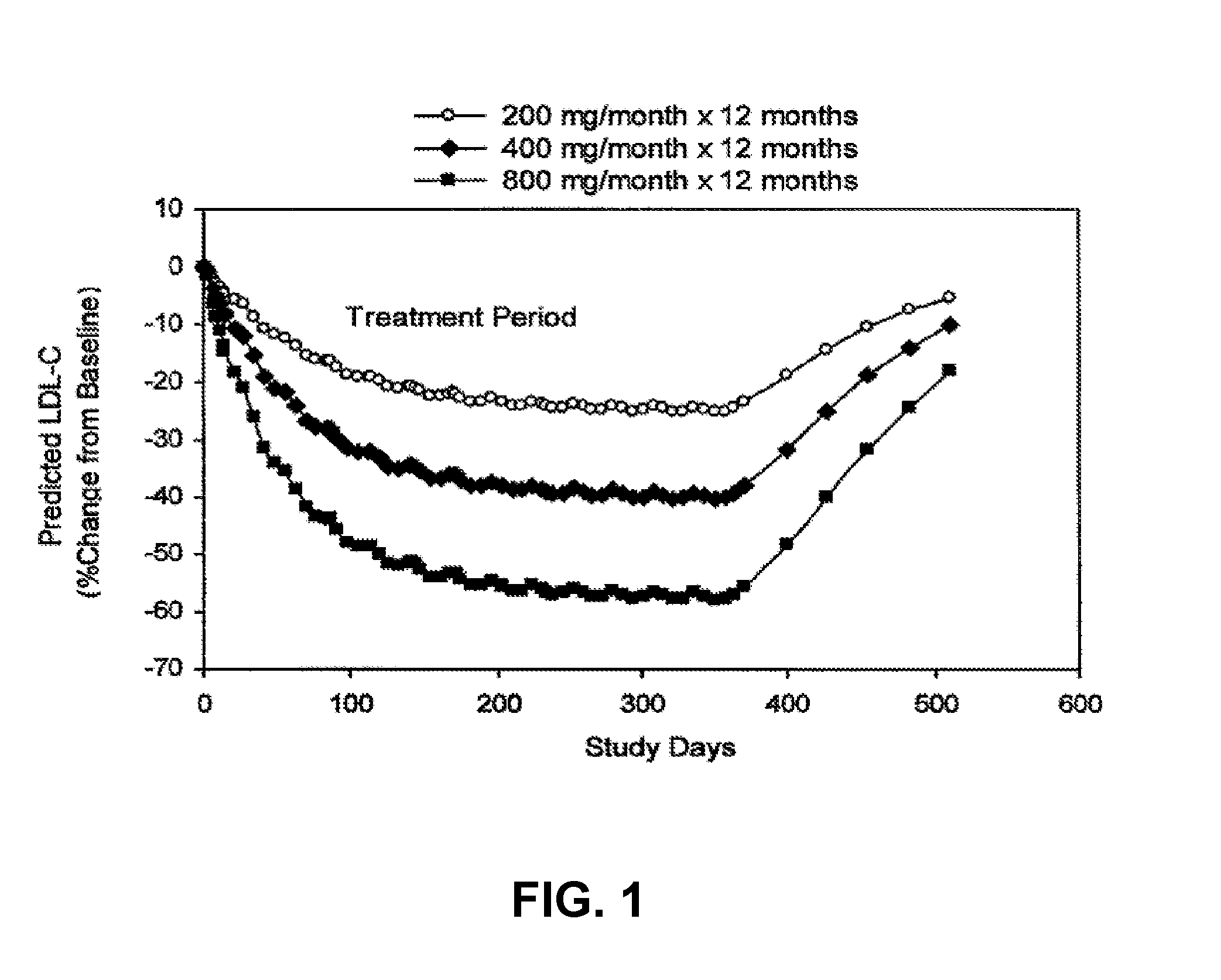Administering antisense oligonucleotides complementary to human apolipoprotein B
a technology of antisense oligonucleotides and human apolipoprotein b, which is applied in the direction of antibody medical ingredients, peptide/protein ingredients, metabolic disorders, etc., can solve the problems of many subjects being unable to lower ldl-cholesterol levels, and achieve the effects of reducing the risk of developing atherosclerosis, reducing the risk of coronary heart disease, and slowing or stopping the progression of atherosclerosis
- Summary
- Abstract
- Description
- Claims
- Application Information
AI Technical Summary
Benefits of technology
Problems solved by technology
Method used
Image
Examples
example 1
Subjects
[0266]Three subjects were identified as having homozygous familial hypercholesterolemia using the following criteria: (1) documented history of LDL-C above 500 mg / dL in the absence of lipid-lowering therapy; and (2) at least one of (a) genetic testing confirming 2 mutated LDL-receptor genes; (b) tendinous and / or cutaneous xanthoma prior to age 10 years; or (c) documentation of elevated LDL-C prior to lipid-lowering therapy consistent with heterozygous familial hypercholesterolemia in both parents (if a parent's medical history was not available, a history of coronary heart disease in a first degree male relative younger than 55 years old or first degree female relative younger than 60 years old was used as a criterion in place of a parent's medical history).
[0267]The three subjects received a 300 mg dose of ISIS 301012 on Days 1, 4, 8, 11, 15, 22, 29, 36, 43, 50, 57, 64, 71, 78, and 85, as summarized in the table, below. ISIS 301012 was administered subcutaneousl...
example 2
Rate and Magnitude of ApoB Reduction with ISIS 301012
[0272]Without being bound to a particular theory, it is believed that mild increases in ALT levels seen during initial treatment with ISIS 301012 in dose regimens having a high multi-dose loading period, reflect extreme lipid lowering activity. Particularly, the rise in ALT can be attributed to the rate and magnitude of lipid lowering. An ALT rise can be lessened or prevented by a dosing regimen that limits the rate and magnitude of ApoB reduction during the induction or initial dosing period, approximately the first 15 to 90 days of treatment. Thus, for the first time, the rate and magnitude of ApoB reduction has been correlated with ALT levels.
Subjects
[0273]Hypercholesterolemics on stable statin therapy. ApoB levels and ALT levels were determined for the subjects in the trial. Table 8 provides the ApoB levels for individual subjects and resulting ALT levels.
[0274]
TABLE 8ApoB and ALT Levels for Individual SubjectsRate of ApoBMin ...
example 3
Reduction in ApoB with ISIS 301012 in Subjects with Polygenic Hypersholeterolemia
Subjects
[0278]Subjects were identified as having polygenic hypercholesterolemia. Subjects typically had LDL-C levels greater than about 130 mg / dL in the absence of lipid-lowering therapy.
Dosing
[0279]Three groups of 8 patients each were dosed. The groups were dosed with 200, 300 or 400 mg of ISIS 301012 once per week for 13 weeks with no initial loading. ISIS 301012 was administered by subcutaneous injection.
[0280]
TABLE 10ApoB levels and and ALT Elevations200mg / wk300 mg / wk400 mg / wk(mg / dL)(mg / dL)(mg / dL)ApoB Baseline130139150(93-150)(109-160)(118-172ApoB at 2 wks−47−61 >−70**(% change frombaseline)ALT Elevations*00 5*ALT elevations ≧3XULN on two consecutive measurements at least 7 days apart**4 of 8 patients reached the lower limit of detection for ApoB
Results
[0281]The drop in ApoB from baseline at 2 weeks for the 200 and 300 mg / kg dose groups resulted, on average in a rate and / or magnitude drop that did n...
PUM
| Property | Measurement | Unit |
|---|---|---|
| concentration | aaaaa | aaaaa |
| concentration | aaaaa | aaaaa |
| concentration | aaaaa | aaaaa |
Abstract
Description
Claims
Application Information
 Login to View More
Login to View More - R&D
- Intellectual Property
- Life Sciences
- Materials
- Tech Scout
- Unparalleled Data Quality
- Higher Quality Content
- 60% Fewer Hallucinations
Browse by: Latest US Patents, China's latest patents, Technical Efficacy Thesaurus, Application Domain, Technology Topic, Popular Technical Reports.
© 2025 PatSnap. All rights reserved.Legal|Privacy policy|Modern Slavery Act Transparency Statement|Sitemap|About US| Contact US: help@patsnap.com



